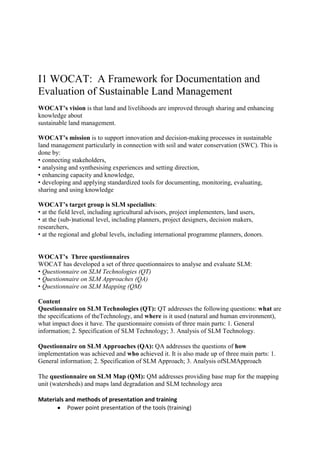I1 WOCAT: A Framework for Documentation and Evaluation of Sustainable Land Management
- 1. I1 WOCAT: A Framework for Documentation and Evaluation of Sustainable Land Management WOCAT’s vision is that land and livelihoods are improved through sharing and enhancing knowledge about sustainable land management. WOCAT’s mission is to support innovation and decision-making processes in sustainable land management particularly in connection with soil and water conservation (SWC). This is done by: • connecting stakeholders, • analysing and synthesising experiences and setting direction, • enhancing capacity and knowledge, • developing and applying standardized tools for documenting, monitoring, evaluating, sharing and using knowledge WOCAT’s target group is SLM specialists: • at the field level, including agricultural advisors, project implementers, land users, • at the (sub-)national level, including planners, project designers, decision makers, researchers, • at the regional and global levels, including international programme planners, donors. WOCAT’s Three questionnaires WOCAT has developed a set of three questionnaires to analyse and evaluate SLM: • Questionnaire on SLM Technologies (QT) • Questionnaire on SLM Approaches (QA) • Questionnaire on SLM Mapping (QM) Content Questionnaire on SLM Technologies (QT): QT addresses the following questions: what are the specifications of theTechnology, and where is it used (natural and human environment), what impact does it have. The questionnaire consists of three main parts: 1. General information; 2. Specification of SLM Technology; 3. Analysis of SLM Technology. Questionnaire on SLM Approaches (QA): QA addresses the questions of how implementation was achieved and who achieved it. It is also made up of three main parts: 1. General information; 2. Specification of SLM Approach; 3. Analysis of SLM Approach The questionnaire on SLM Map (QM): QM addresses providing base map for the mapping unit (watersheds) and maps land degradation and SLM technology area Materials and methods of presentation and training Power point presentation of the tools (training)
- 2. Posters Leaflets and flyers Accessing WOCAT website Production of outputs Analysis Map output Report Material for knowledge dissemination Networking RNECAT – WOCAT Milestones in the Near East

